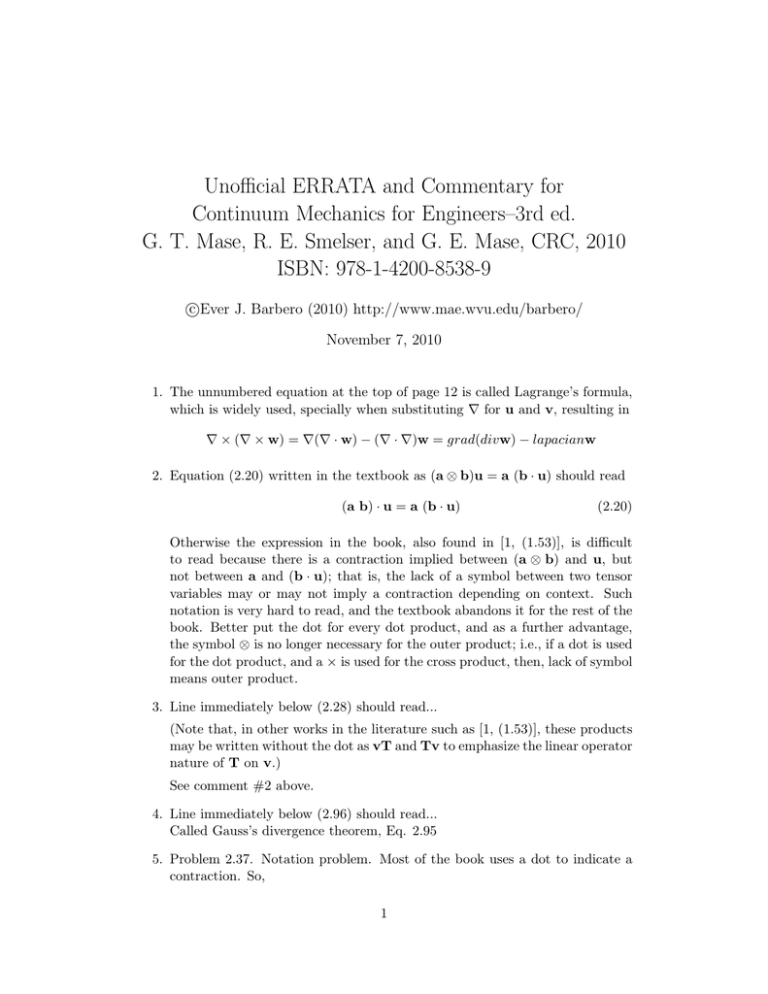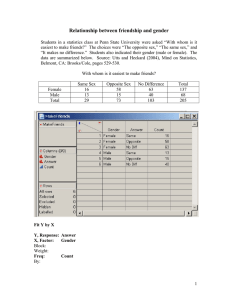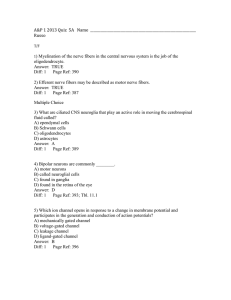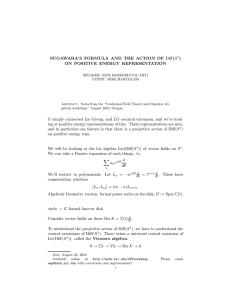Unofficial ERRATA and Commentary for Continuum Mechanics for Engineers–3rd ed.
advertisement

Unofficial ERRATA and Commentary for
Continuum Mechanics for Engineers–3rd ed.
G. T. Mase, R. E. Smelser, and G. E. Mase, CRC, 2010
ISBN: 978-1-4200-8538-9
c
Ever
J. Barbero (2010) http://www.mae.wvu.edu/barbero/
November 7, 2010
1. The unnumbered equation at the top of page 12 is called Lagrange’s formula,
which is widely used, specially when substituting ∇ for u and v, resulting in
∇ × (∇ × w) = ∇(∇ · w) − (∇ · ∇)w = grad(divw) − lapacianw
2. Equation (2.20) written in the textbook as (a ⊗ b)u = a (b · u) should read
(a b) · u = a (b · u)
(2.20)
Otherwise the expression in the book, also found in [1, (1.53)], is difficult
to read because there is a contraction implied between (a ⊗ b) and u, but
not between a and (b · u); that is, the lack of a symbol between two tensor
variables may or may not imply a contraction depending on context. Such
notation is very hard to read, and the textbook abandons it for the rest of the
book. Better put the dot for every dot product, and as a further advantage,
the symbol ⊗ is no longer necessary for the outer product; i.e., if a dot is used
for the dot product, and a × is used for the cross product, then, lack of symbol
means outer product.
3. Line immediately below (2.28) should read...
(Note that, in other works in the literature such as [1, (1.53)], these products
may be written without the dot as vT and Tv to emphasize the linear operator
nature of T on v.)
See comment #2 above.
4. Line immediately below (2.96) should read...
Called Gauss’s divergence theorem, Eq. 2.95
5. Problem 2.37. Notation problem. Most of the book uses a dot to indicate a
contraction. So,
1
• (a) should be
[A · a, A · b, A · c] = detA[a, b, c]
• (b) should be
AT · ((A · a) × (A · b)) = detA(a × b)
6. I fount it advantageous to compare Section 5.5 on p. 176, to the part of Section
3.4 after equation (3.27) on p. 62.
7. (3.56) should read
2
2 2
2
σS2 = σI2 n21 + σII
n2 + σIII
n23 − σI n21 + σII n22 + σIII n23
(3.56)
8. (3.57) should read
2
2
σS2 = (σI2 − σIII
) ∗ n21 + (σII
2
2
2
− σIII
) ∗ n22 + σIII
− (σI − σIII ) ∗ n21 + (σII − σIII ) ∗ n22 + σIII (3.57)
9. (3.58) should read
∂σS2
= n1 ∗ (σI − σIII ) ∗ σI − σIII − 2 ∗ (σI − σIII ) ∗ n21 + (σII − σIII ) ∗ n22
∂n1
(3.58a)
2
∂σS
= n2 ∗ (σII − σIII ) ∗ σII − σIII − 2 ∗ (σI − σIII ) ∗ n21 + (σII − σIII ) ∗ n22
∂n2
(3.58b)
10. The second term (convection part) of the symbolic term in (4.32) should be
corrected as follows
d
∂()
∂()
=
+ vk
dt
∂t
∂xk
;
d()
∂()
=
+ ∇() · v
dt
∂t
(4.32)
For example, the acceleration is
ai =
∂vi
dvi
∂vi
=
+ vk
dt
∂t
∂xk
(4.32’)
The MATLAB code below illustrates it by extending Example 4.4 to recalculate the acceleration in Eulerian coordinates without ever using the Lagrangian
expressions, and reaching the same result as in Ex. 4.4.
% Ex 4.4 plus material derivative
% (c) Ever Barbero (2010)
clear, clc
2
syms X1 X2 X3 t x1 x2 x3
% Lagrangean motion equations
X = [X1; X2; X3]
xx1 = X1*exp(t)+X3*(exp(t)-1)
xx2 = X2+X3*(exp(t)-exp(-t))
xx3 = X3
% Invert to find the Eulerian motion equations
XX = solve(x1-xx1,x2-xx2,x3-xx3,X1,X2,X3)
X = [XX.X1; XX.X2; XX.X3]
%
x
v
a
Lagrangean velocity and acceleration vectors (columns)
= [xx1; xx2; xx3]
= simplify(diff(x,t))
= simplify(diff(v,t))
% Eulerian velocity and acceleration vectors
V1 = simplify(subs(v(1),{X1,X2,X3},{X(1),X(2),X(3)}));
V2 = simplify(subs(v(2),{X1,X2,X3},{X(1),X(2),X(3)}));
V3 = simplify(subs(v(3),{X1,X2,X3},{X(1),X(2),X(3)}));
V = [V1; V2; V3]
A1 = simplify(subs(a(1),{X1,X2,X3},{X(1),X(2),X(3)}));
A2 = simplify(subs(a(2),{X1,X2,X3},{X(1),X(2),X(3)}));
A3 = simplify(subs(a(3),{X1,X2,X3},{X(1),X(2),X(3)}));
A = [A1; A2; A3]
% Material devirative
% Find the Eulerian acceleration using the material derivative operator
% on the Eulerian velocity vector never going back to Lagrangean
gradV(1,1) = diff(V(1),x1);
gradV(1,2) = diff(V(1),x2);
gradV(1,3) = diff(V(1),x3);
gradV(2,1) = diff(V(2),x1);
gradV(2,2) = diff(V(2),x2);
gradV(2,3) = diff(V(2),x3);
gradV(3,1) = diff(V(3),x1);
gradV(3,2) = diff(V(3),x2);
gradV(3,3) = diff(V(3),x3);
gradV
temp = gradV*V % convection term on (4.32 corrected)
3
% temp = (V’*gradV)’ % convection term on (4.32 uncorrected) is wrong
AA = diff(V,t) % time derivative in (4.32)
AA = AA+temp %(4.32 corrected) yields the same Eulerian acceleration as A above
11. First line, p. 132, substitute ‘(unit elongation)’ for ‘(longitudinal strain)’
because e(Nb ) is not a strain in the sense that E11 or ε11 are. See (4.113)
and discussion that follows. The word strain is used incorrectly several time
in this section; e.g., line before (4.116).
12. In Problem 3.9, p. 92, should be t31 = −Cx2 . Note that the stress tensor must
be symmetric.
13. First line in Section 4.10 should read ‘In Chapter 2 (Example 2.7) we noted...’
14. Page 135, 7th line after (4.120b), substitute ‘Eq 4.119’for ‘Eq 4.120b’
15. p. 136, last line before Example 4.15, which in the book reads “using C−1 =
F · FT = V2 ” should read “using c−1 = F · FT = V2 ”, that is, V2 is the
inverse of the Cauchy deformation tensor c = F−T · F−1 (4.48). Note that the
Cauchy deformation tensor c is not the same as the Green deformation tensor
C, thus making this typo a nasty one to discover.
16. Equation (4.159) is called Nanson’s formula. It relates the infinitesimal area
between the undeformed dS0 and deformed dS configurations. Obviously,
XA,q = F−T , so, Nanson’s formula is usually written to highlight the participation of (the inverse of) the deformation gradient as follows
dS = J F−T · dS0
Immediately after this, or at the end of this section 4.12, I teach section 5.4,
which I feel is otherwise orphan in Chapter 5.
17. In Problem 4.36, (b) should read ‘(b) the stretch rate per unit stretch...’, not
‘per unit length...‘
18. In Problem 4.42, v2 = ex3 −kt sin ωt should read v2 = ex3 −ct sin ωt
19. Problem 4.42, solution for part (c) is wrong because the statement of the
problem calls for a direction
√
b = (b
n
e1 + b
e2 )/ 2
The correct solution is
d ln Λ
=0
dt
4
Otherwise, if you change the statement of the problem for a direction
√
b = (b
n
e1 + b
e3 )/ 2
then, the solution given in the book is correct.
20. To derive the equation before (5.2), use equation (4.161), J˙ = vk,k J.
21. Equation above (5.3) has the subscript k repeated three times, which violates
one of the rules of indicial notation. You must delete the second k inside the
parenthesis,
Z h
i
∗
=
... + vk Pij...
dV
,k
V
which upon application of the divergence theorem [specifically (2.95)] becomes
22. Equation above (5.18) is missing a J
Z
=
Ȧij... ρ J dV 0 = ...
V0
23. Line after (5.57), does not agree with terminology in other references (e.g., [1,
(4.84)]) in that S defined in (5.57) is the stress power, not the stress work. In
fact, the stress work is
Z
tij ij dV
V
where ij =
1
2
(ui,j + uj,i ) is the linear strain.
Errata for the Solutions Manual
This section applies only if you are an instructor and thus are legally entitled to have
a copy of the solutions manual. If you are a student that somehow got a copy of the
solutions manual and you are consulting it, your behavior is unethical and it only
hurts you. The textbook exercises at the end of chapters are designed to force you
to understand the material. If you don’t, you should ask the instructor. Otherwise,
just looking at the solutions makes everything look easy and you are missing a big
chunk of your learning; you are not developing your skills in the subject.
• Problem 2.19. There are several typos and mistakes on the last four lines of
equations. Make sure you work them out yourself before you assign it to the
students.
• Problem 2.21. The third equation of section (b) of the solution has a redundant
‘= √12 ’ on its LHS.
• Problem 3.15. There is a typo repeated twice in the solution. To correct it,
note that the statement on p. 95 reads (a) the principal stresses σI , σII , σIII .
5
• Problem 4.12. The answer is correct but the solution is incomplete.
• Problem 4.15. The second part of the first line in the solution
(1)
ui
(1)
= Aij Xj
;
(2)
ui
(2)
= Aij Xj
dealing with the second deformation (2) is confusing as stated. The solution
path becomes more clear and the students are able to successfully complete
the problem if said line is given as
(1)
ui
(1)
= Aij Xj
;
(2)
ui
(2)
(1)
= Aij Xj
where
(1)
Xj
(1)
= Xj + uj
are the updated Lagrangean coordinates of the particle after deformation (1)
is completed.
• Problem 4.36, part (d), it is much easier and intuitive to calculate
γ̇max =
λ(1) − λ(3)
2
i.e., one half of the difference between the largest and smallest principal values
of the rate of deformation tensor.
References
[1] Holzapfel, G. A. (2000) Nonlinear Solid Mechanics, Wiley.
6







